AOC G2460PQU 24-inch 144 Hz Gaming Monitor Review
Not many monitors can run at 144 Hz, but AOC is adding to your list of choices with its G2460PQU 24-inch TN-based screen. We’ve already tested similar displays from Asus and BenQ. Can AOC match their speed and performance at a roughly $250 price point?
Why you can trust Tom's Hardware
Measurement And Calibration Methodology: How We Test
To measure and calibrate monitors, we use an i1Pro spectrophotometer, a Spectracal C6 colorimeter, and version 5.2.0.1374 of SpectraCal’s CalMAN software.
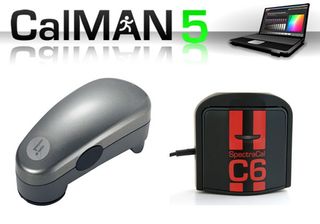
The i1Pro is very accurate and consistent measuring color on all types of displays, regardless of the backlight technology used. When we just need a luminance value, the C6 works better, especially in low light.
For patterns, we employ AccuPel DVG-5000 and DVDO AVLab TPG video signal generators. This approach removes video cards and drivers from the signal chain, allowing the display to receive true reference patterns. Connections are made via HDMI.
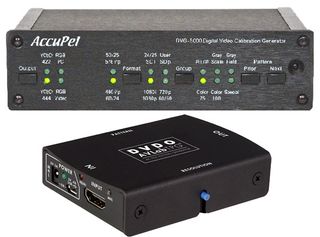
The AccuPel DVG-5000 is capable of generating all types of video signals at any resolution and refresh rate up to 1920x1080 at 60 Hz. It can also display motion patterns to evaluate a monitor's video processing capabilities, with 3D patterns available in every format. This allows us to measure color and grayscale performance, crosstalk, and ghosting in 3D content via the 3D glasses.
The DVDO generator is a new addition to our lab. It supports resolutions up to 4096x2160. We’re using it to verify the proper signal handling of QHD and UHD displays.
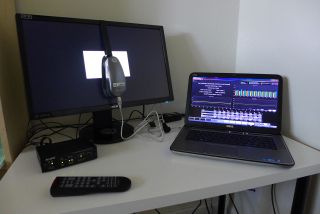
The i1Pro or C6 is placed at the center of the screen (unless we’re measuring uniformity) and sealed against it to block out any ambient light. The AccuPel pattern generator (bottom-left) is controlled via USB by CalMAN, which is running on the Dell XPS laptop on the right.
Our version of CalMAN Ultimate allows me to design all of the screens and workflows to best suit the purpose at hand. To that end, I’ve created a display review workflow from scratch. This way, we can be sure and collect all the necessary data with a concise and efficient set of measurements.
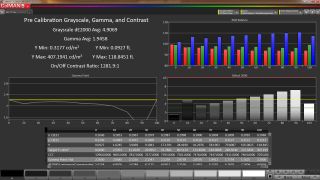
The charts show us the RGB levels, gamma response, and Delta E error for every brightness point from zero to 100 percent. In the table, we get raw data for each measurement. And the area in the upper-left tells us luminance, average gamma, Delta E, and contrast ratio. The individual charts can be copied to the Windows clipboard to easily create graphics for our reviews.
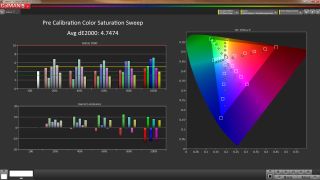
Every primary and secondary color is measured at 20-, 40-, 60-, 80-, and 100-percent saturation. The color saturation level is simply the distance from the white point on the CIE chart. You can see the targets moving out from white in a straight line. The further a point is from center, the greater the saturation until you hit 100 percent at the edge of the gamut triangle. This shows us the display’s response at a cross-section of color points. Many monitors score well when only the 100-percent saturations are measured. Hitting the targets at the lower saturations is more difficult, and factors into our average Delta E value (which explains why our Delta E values are sometimes higher than those reported by other publications).
Current page: Measurement And Calibration Methodology: How We Test
Prev Page OSD Setup And Calibrating AOC's G2460PQU Next Page Results: Brightness And ContrastStay on the Cutting Edge
Join the experts who read Tom's Hardware for the inside track on enthusiast PC tech news — and have for over 25 years. We'll send breaking news and in-depth reviews of CPUs, GPUs, AI, maker hardware and more straight to your inbox.

Christian Eberle is a Contributing Editor for Tom's Hardware US. He's a veteran reviewer of A/V equipment, specializing in monitors. Christian began his obsession with tech when he built his first PC in 1991, a 286 running DOS 3.0 at a blazing 12MHz. In 2006, he undertook training from the Imaging Science Foundation in video calibration and testing and thus started a passion for precise imaging that persists to this day. He is also a professional musician with a degree from the New England Conservatory as a classical bassoonist which he used to good effect as a performer with the West Point Army Band from 1987 to 2013. He enjoys watching movies and listening to high-end audio in his custom-built home theater and can be seen riding trails near his home on a race-ready ICE VTX recumbent trike. Christian enjoys the endless summer in Florida where he lives with his wife and Chihuahua and plays with orchestras around the state.
-
PandaV4 I have a AOC G2460P monitor myself, and a unpleasant surprise was that refresh rate of 144 Hz wasn't supported if using the DisplayPort connection. Does G2460PQU have the same limitations, or does it actually support 144 Hz over DisplayPort?Reply -
PandaV4 After some googling it seems that G2460PQU and G2460P is the same model. So beware if you want to use Displayport you wont be able to use the 144 Hz setting too! And this doesn't have any blur reduction either! It seems there is actually a new updated model to be released this month the AOC G2460PG. And it has nvidia g-sync support and blur reduction, and supports 144 over dIsplayport.Reply
TL;DR: G2460PQU = DO NOT BUY, G2460PG = BUY. -
ceberle Reply13687399 said:I have a AOC G2460P monitor myself, and a unpleasant surprise was that refresh rate of 144 Hz wasn't supported if using the DisplayPort connection. Does G2460PQU have the same limitations, or does it actually support 144 Hz over DisplayPort?
The PQU does accept 144 Hz over DisplayPort.
-Christian- -
PandaV4 Reply
A bit of googling brought up this article - http://pcmonitors.info/reviews/aoc-g2460pqu which says: " The image provided by DisplayPort is very similar on this monitor and it should also support the maximum (144Hz) refresh rate. Unfortunately that was not the case during our testing" and "The PC resolutions below this should feature 1920 x 1080 with 100Hz, 120Hz and 144Hz selectable – but that isn’t the case.". It seems there are different revisions of this monitor with the same model number. So if you buy one of those than you are practically gambling about the 144 Hz support.13688062 said:13687399 said:I have a AOC G2460P monitor myself, and a unpleasant surprise was that refresh rate of 144 Hz wasn't supported if using the DisplayPort connection. Does G2460PQU have the same limitations, or does it actually support 144 Hz over DisplayPort?
The PQU does accept 144 Hz over DisplayPort.
-Christian-
-
npyrhone Will we ever see here a review of even one non-TN gaming monitor? The reduced color depth renders to image quality absolutely disgusting.Reply
I will be the first one to congratulate you when you publish the next review of a monitor with a non-TN panel working over 60Hz. -
3Dns I have that model too and i buy it after a HP 23xi IPS LED Panel.Reply
I understand that.
It doesnt worth 300€ for this model. All you need is 60hz and 24" Panel that you can take it with 120€. For me IPS Panels offer you way better colors so for me its better. Now if you want it for a GTX780 and above and you wanna play over 60FPS it may worth.
But have in mind that a normal monitor cost ~120$ and this model cost double. You can spend that money in other hardware areas like better GPU for example. -
Adroid Sorry, but I won't ever buy another 1080p "gaming" display. 1920x1200 is vastly superior for "gaming" screens, and it's a shame the industry has veered away from it.Reply
I guess the thought process involves "and you can watch HD movies on it". Needless to say the 16:9 ratio is cheaper for manufacturers, and it's a great sales pitch. Well, give me a break. I got suckered into that line of thinking and I probably watched 2-3 movies on my "gaming" 23 inch monitor in 4-5 years.
Let's keep the movies where they belong in the living room and re-focus "gaming" screens where they should have never left - in the 16:10 aspect ratio. -
alchemy69 If a game isn't enjoyable at 60Hz it isn't going to be enjoyable at 144Hz. And if it is enjoyable at 144, it still will be at 60. I've had some of the greatest fun over the last 30 years playing on tiny monitors, at low resolution and probably less than 30fps. I don't need the industry telling me what I need to have fun just so they can move more product.Reply
